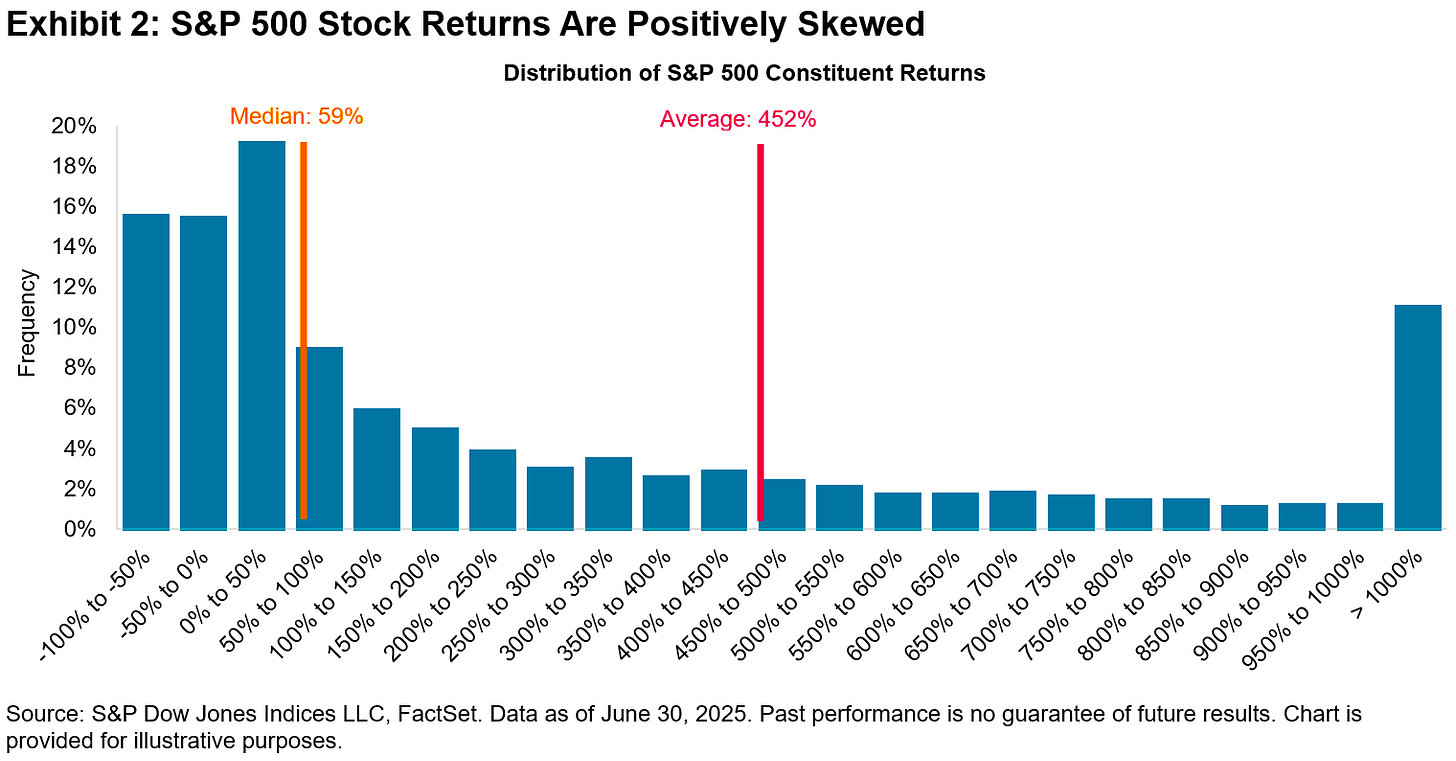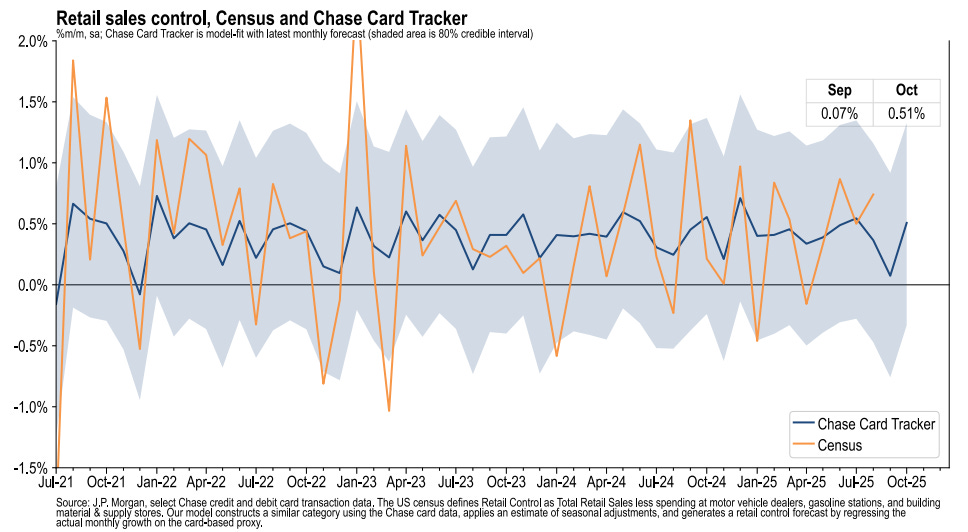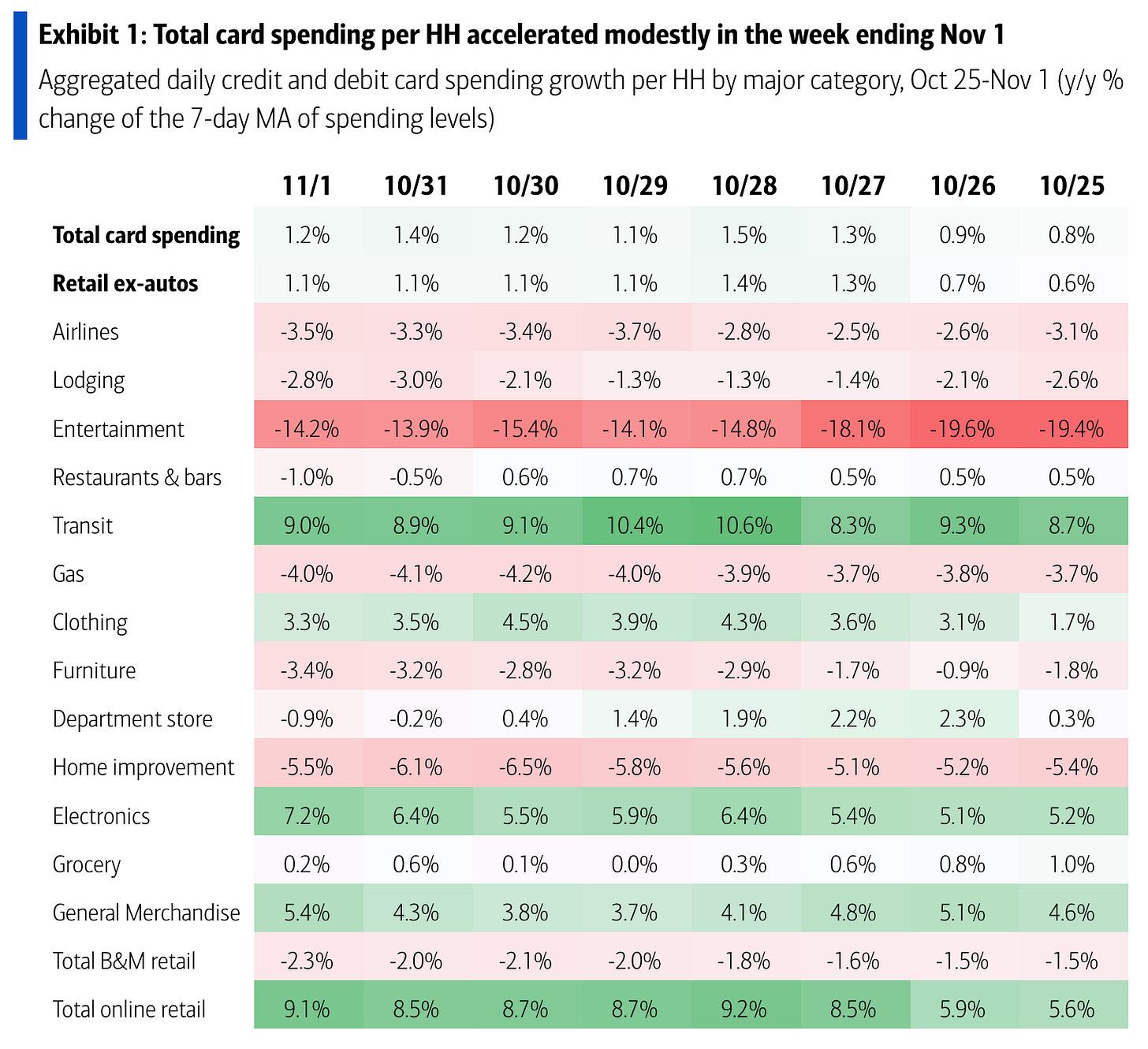No official jobs data, but the unofficial data is unambiguously discouraging 💼
Plus a charted review of the macro crosscurrents 🔀
📉The stock market fell last week, with the S&P 500 shedding 1.6% to close at 6,728.80. The index is now down 2.4% from its Oct. 29 closing high of 6,890.89 and up 14.4% year-to-date. For more on recent market moves, read: The stock market and the economy are diverging 📊
-
We’re in the second month of the government shutdown, which means we’re still not getting comprehensive economic survey data from federal agencies like the Bureau of Labor Statistics (BLS).
Fortunately, there are private agencies that also track and regularly publish various economic data.
And almost all of that data confirms that the labor market continues to cool, increasing the risk that the economy tips into recession.
Let’s review some of the recent numbers.
Job creation is stalling
According to payroll processor ADP, private sector employers added just 42,000 jobs in October. While the number was positive, it also confirmed a months-long trend in declining job creation.

Revelio Labs, which analyzes online professional profiles, estimates nonfarm payroll employment, which includes public and private sector employers, fell by 9,100 jobs in October.
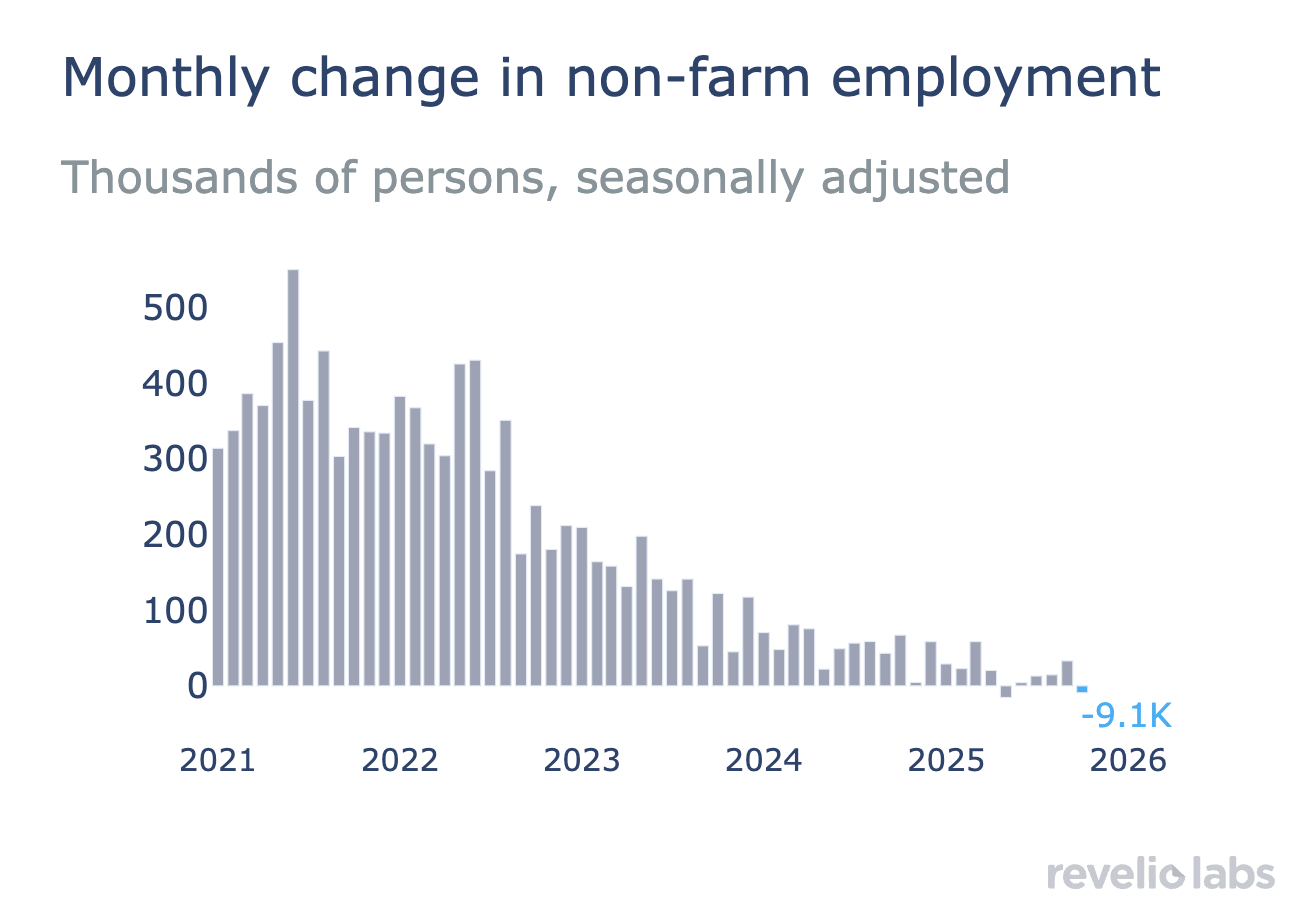
LinkUp, which scrapes job listings from employer websites, estimates nonfarm payroll employment declined by 5,000 jobs.
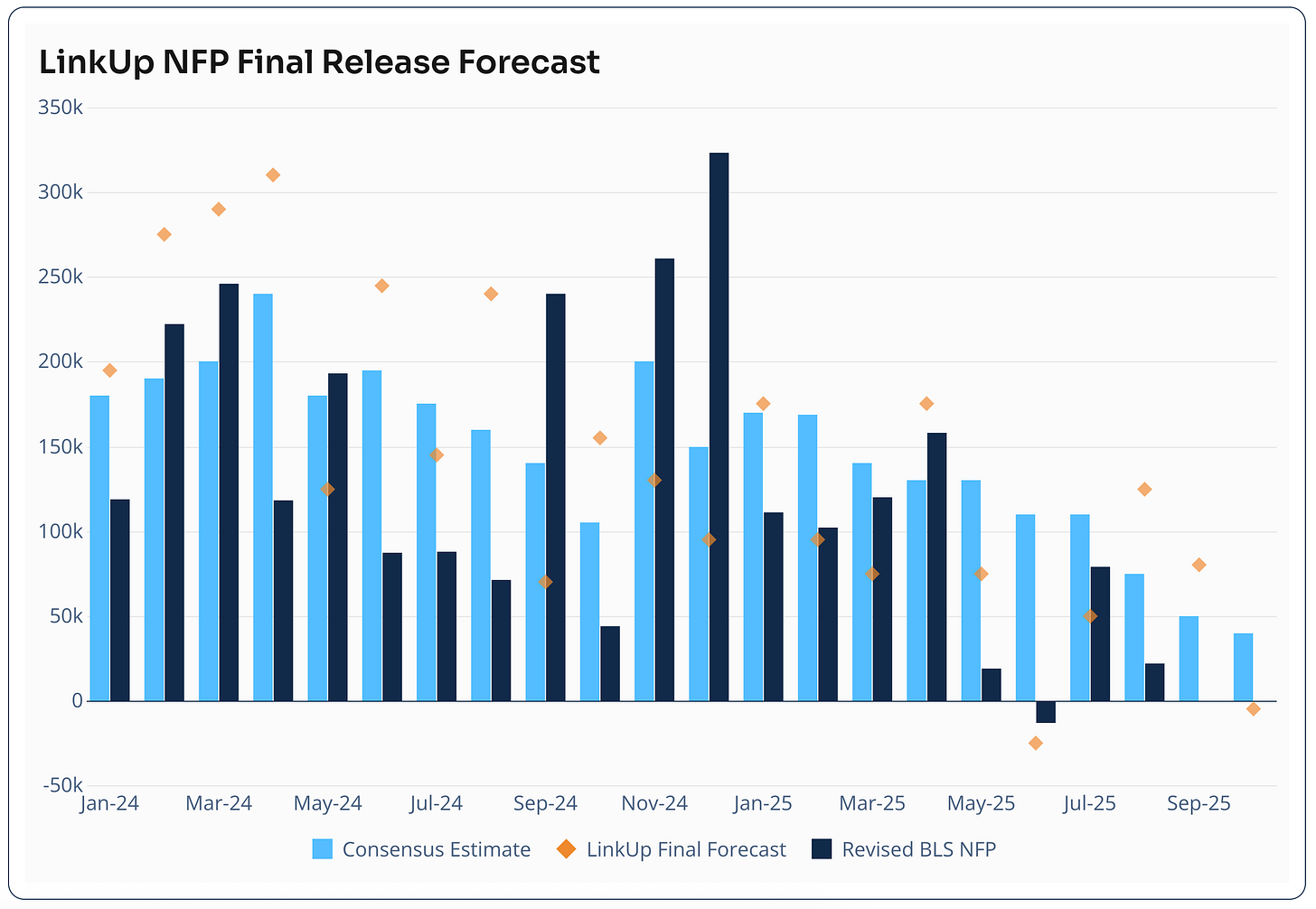
These stats are consistent with the trend in BLS data, which showed net job creation had fallen to near zero in May through August.
Job openings are falling
According to job postings site Indeed, “As of October 31, job postings had slumped to their lowest level since 2021, with year-over-year declines recorded in almost every sector tracked by Indeed.”

These findings are consistent with the most recent BLS data, which showed job openings had fallen to their lowest level since early 2021.
Hiring activity is slowing, workers are staying put
According to Revelio Labs, the hiring rate continued to fall through October, suggesting companies have become less eager to fill open roles or add to staff. Similarly, attrition rates have fallen, suggesting employees are holding tight to their jobs or aren’t finding better opportunities elsewhere.
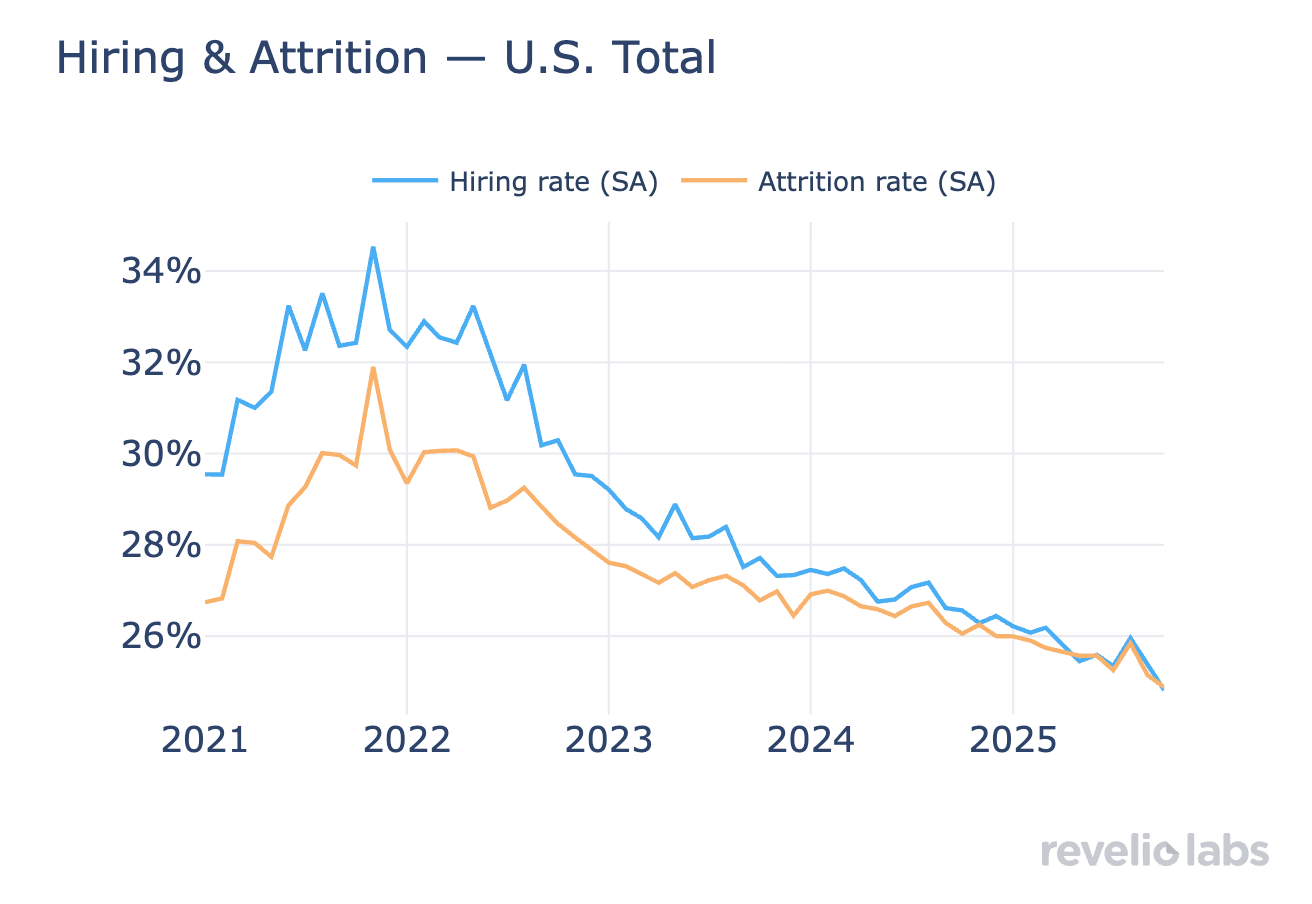
Outplacement firm Challenger, Gray & Christmas, which tracks hiring plans in corporate announcements and public filings, said employers planned to hire 283,138 workers in October. Here’s UBS with some context: “Looking ahead, seasonal hiring does not look very strong this holiday season… The sum of September and October seasonally adjusted total hiring plans is 400K, well below the 625K average in the 2014 to 2019 period, 625K in 2023 and 670K in 2024.”
This sentiment was confirmed in the Conference Board’s October consumer confidence survey, which found that a relatively low percentage of consumers said jobs were “plentiful,” while a growing percentage said jobs were “hard to get.” Economists monitor the spread between these two percentages (a.k.a., the labor market differential). The direction of the differential has been reflecting deteriorating confidence in the job market.
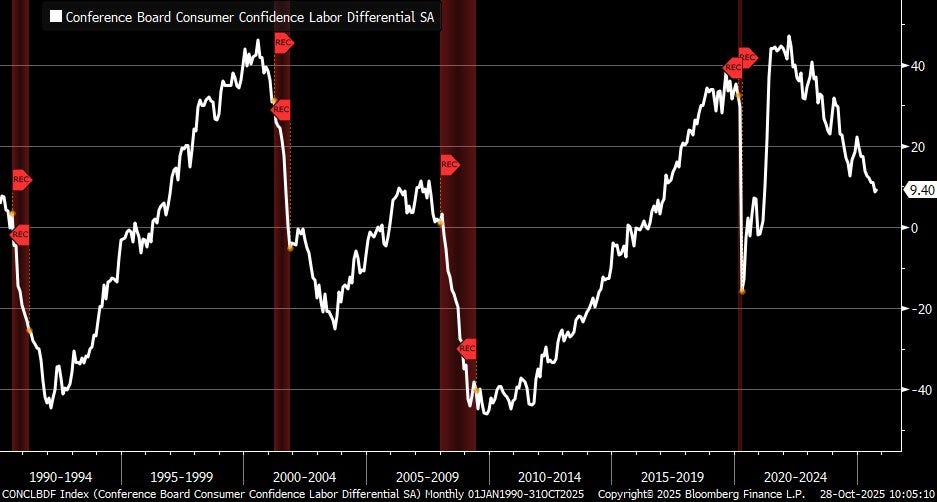
The New York Fed’s Survey of Consumer Expectations found that consumers are becoming less optimistic about finding a job if they were to lose theirs today.
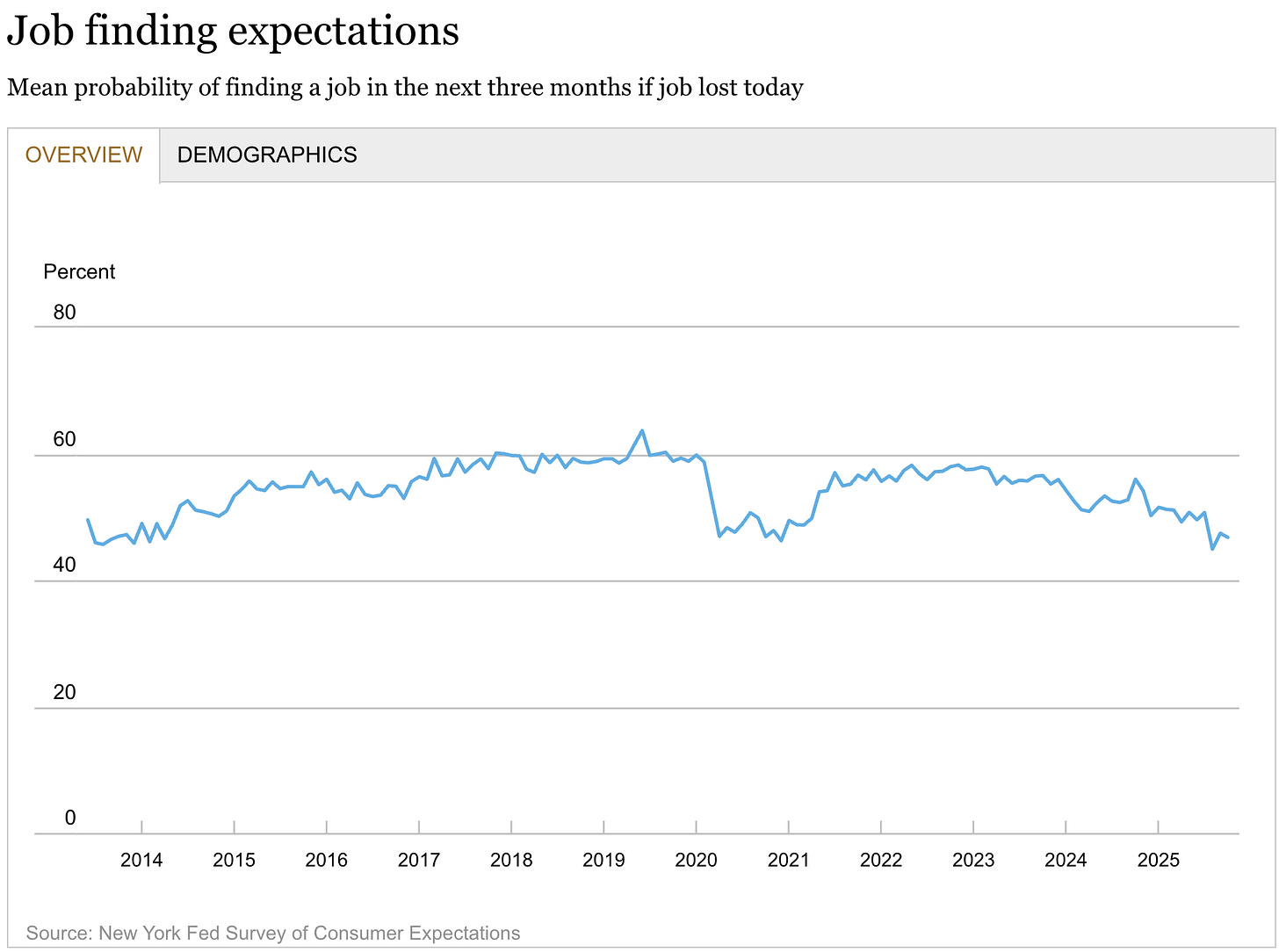
All of this is consistent with the most recent BLS data, which showed hiring and quits rates falling below prepandemic levels.
Layoffs and unemployment may be picking up
Challenger, Gray & Christmas, which tracks layoffs in corporate announcements and regulatory filings, said U.S. employers announced 153,074 job cuts in October.
The firm noted this was the highest total for a single month in the fourth quarter since 2008.
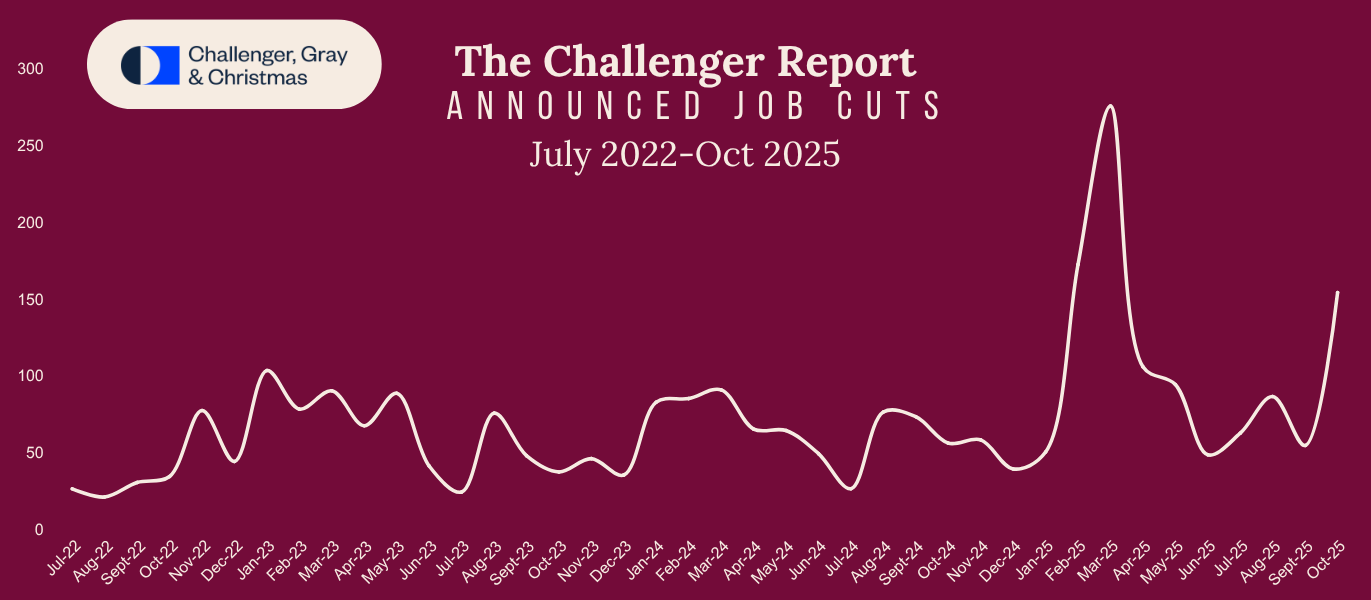
Year to date, employers announced 1,099,500 job cuts, the firm reported.
These figures are unsettling. But it’s also worth noting that the sample represents a relatively small segment of the economy. Most layoffs occur quietly and are not made public.
According to the BLS, which uses surveys to estimate labor market turnover across the economy, U.S. employers lay off about 1.5 million to 2 million workers per month, even during economic booms. In August, employers laid off 1.7 million people, but that figure also represented just 1.1% of total employment.
That said, it’s not a stretch to assume layoff activity is picking up based on everything else we know.
The Chicago Fed has a model that combines a bunch of available data to estimate the unemployment rate. And based on what’s out there, they estimate the unemployment rate was near 4.4% in October, which would be the highest rate in four years.
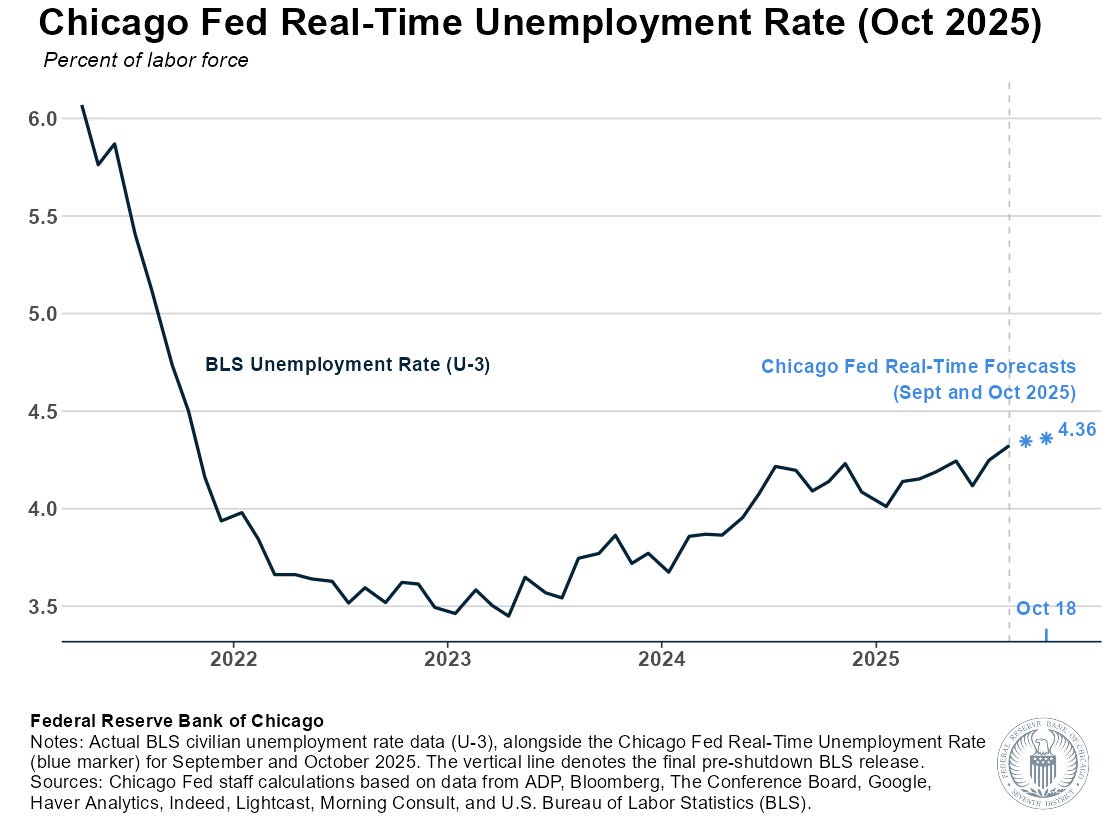
According to the New York Fed’s Survey of Consumer Expectations, a growing percentage of consumers expect the unemployment rate to be higher a year from now.

Citing University of Michigan consumer survey data, UBS notes 71% of consumers expect higher unemployment in 12 months.
Again, we won’t have a more precise assessment of layoff activity and unemployment until we get a more comprehensive survey, like the one conducted monthly by the BLS. But for now, the anecdotes and unofficial data suggest these metrics are deteriorating.
Wage growth is cooling
According to Indeed, wages in job postings continue to cool.
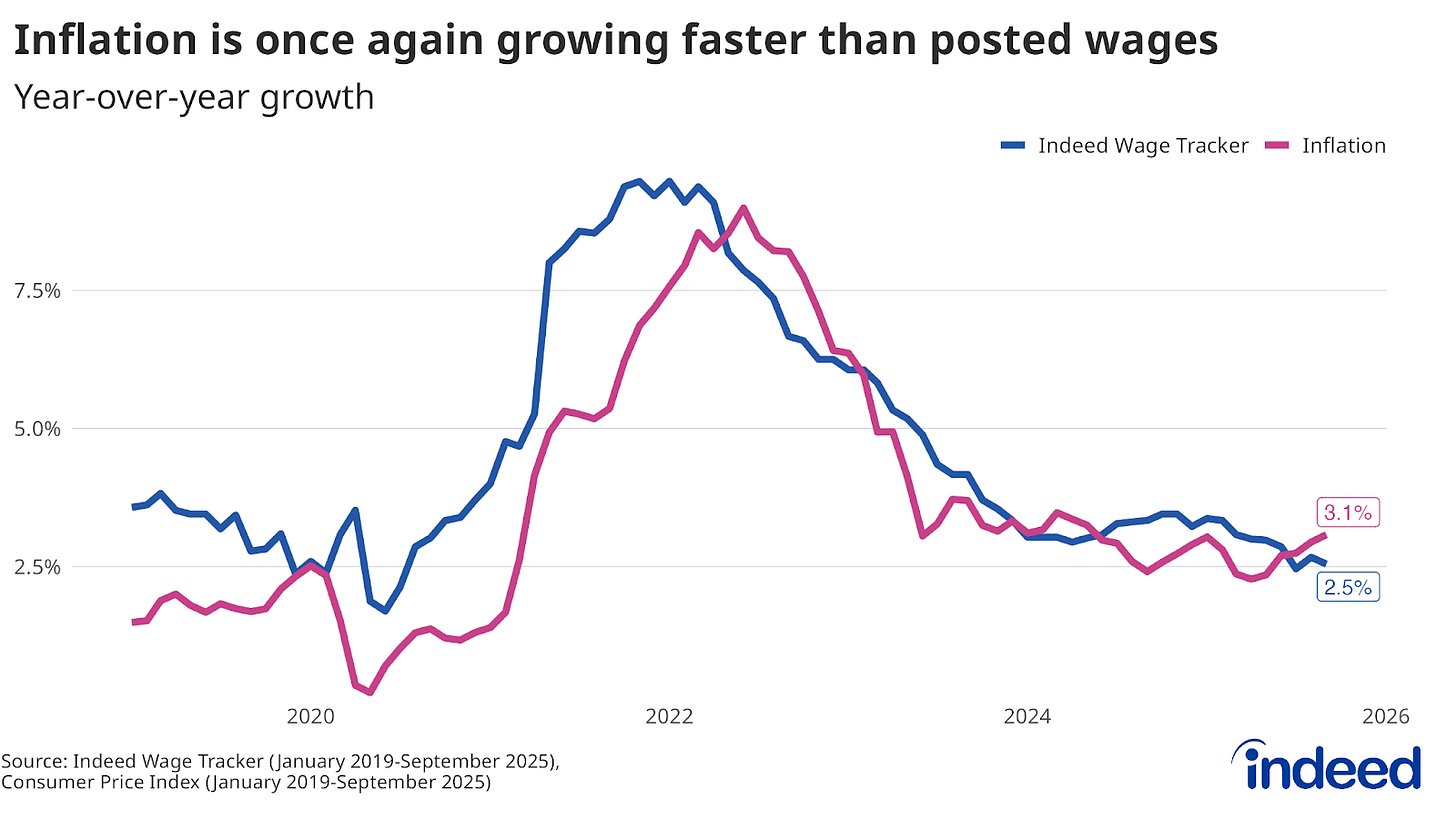
Similarly, ADP’s Pay Insights data shows that wage growth for those changing jobs or staying at jobs has plateaued.
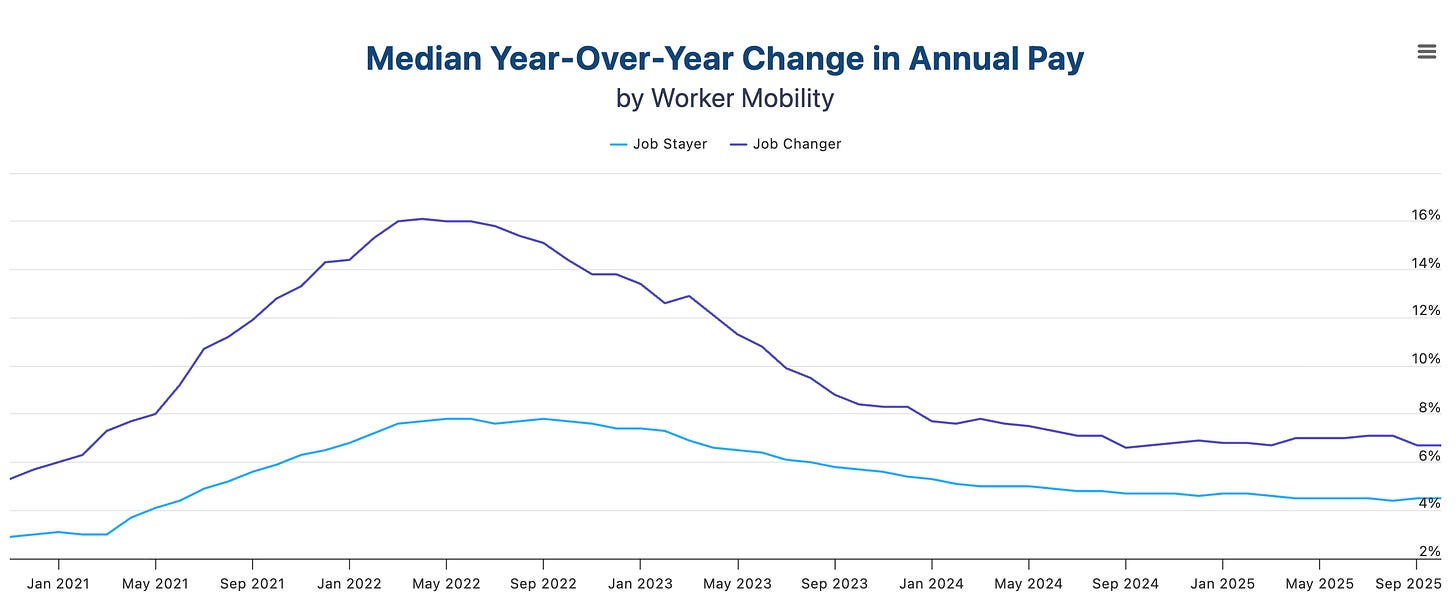
Slowing wage growth is consistent with a labor market with fewer opportunities.
Bad for the economy, but not yet bad for the stock market 🎭
The labor market isn’t as hot as it was. Whenever the official data comes back, we could very well learn that unemployment is becoming a problem and that the economy may be in recession.
But this is also happening as we’re experiencing a potential productivity boom with the emergence of AI technology. Analysts expect this to be a tailwind for profit margins and earnings growth in the years to come. All of this explains why the stock market continues to trade near all-time highs.
Unfortunately, this development is also associated with job cuts as some industries and job sectors have a rocky transition to AI.
And so we have this counterintuitive dynamic where the economy could lag as the stock market trends higher. Because while the economy may not be working for everyone right now, it’s at least working for stock market investors.
The key question is: How bad could things get for the economy before they improve?
Corporate earnings can only grow so much on productivity gains alone. It’s hard for revenue to grow without economic growth, and without revenue growth, earnings will eventually suffer. And earnings are the most important driver of stock prices.
-
Related from TKer:
Review of the macro crosscurrents 🔀
There were several notable data points and macroeconomic developments since our last review:
🚨Due to the government shutdown, we are not getting economic data from federal agencies, including the Census Bureau, the Bureau of Labor Statistics, and the Bureau of Economic Analysis. Until the government reopens, we’ll be leaning more on private sources of data.
👆The labor market is cooling. Recent reports from ADP, LinkUp, Revelio Labs, and Challenger confirm as much. For more, see the charts and stats above.
💳 Card spending data is holding up. From JPMorgan: “As of 24 Oct 2025, our Chase Consumer Card spending data (unadjusted) was 1.8% above the same day last year. Based on the Chase Consumer Card data through 24 Oct 2025, our estimate of the US Census September control measure of retail sales m/m is 0.07%.”
From BofA: “Total card spending per HH was up 1.2% y/y in the week ending Nov 1, according to BAC aggregated credit & debit card data. Y/y entertainment spending growth recovered modestly last week. Clothing, electronics and online retail accelerated. Furniture, restaurants & bars, and department stores saw the biggest drop in y/y spending growth in the week ending Nov 1.“
For more on economic activity, read: 9 once-hot economic charts that cooled 📉 and We’re at an economic tipping point ⚖️
💰 Household finances could be better, but are mostly normalizing. From the New York Fed’s Q3 Household Debt & Credit report: “Transition into early delinquency held steady for nearly all debt types. Transition rates into serious delinquency, defined as 90 or more days past due, were largely stable for auto loans, credit cards, and mortgages, and edged up slightly for HELOCs. Delinquency transitions continued to rise for student loans, but stock delinquency for student loans has largely stabilized since the 4-year pause on reporting.”

While the rate at which debt is entering delinquency is mixed, the total amount of debt in delinquency remains low, at just 4.5% of outstanding debt.
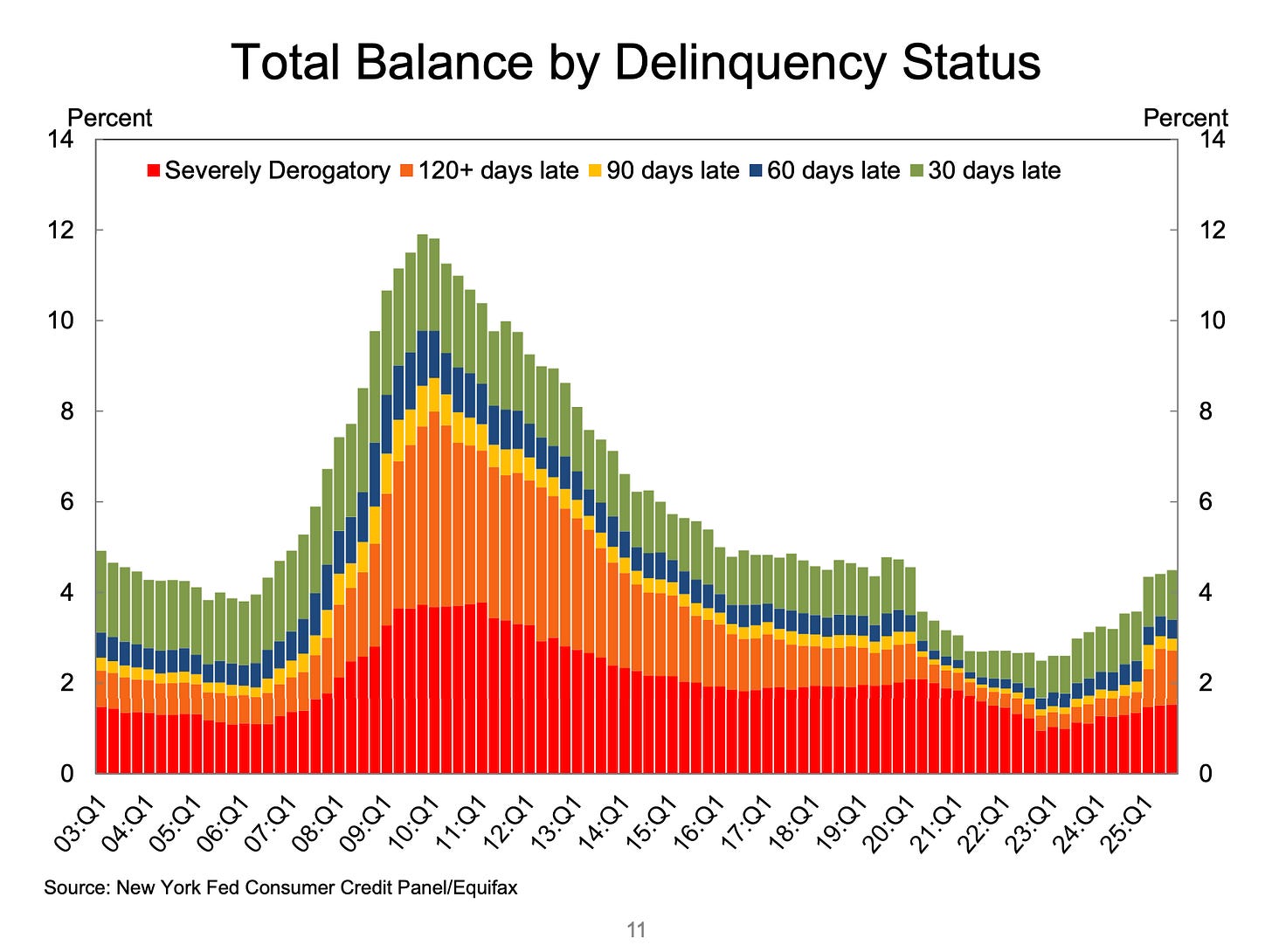
And while credit card debt balances often steal headlines, it’s a mistake to suggest consumers are maxing out their credit cards. The $1.2 trillion in credit card balances as of Q3 represents just a tiny fraction of credit card limits.
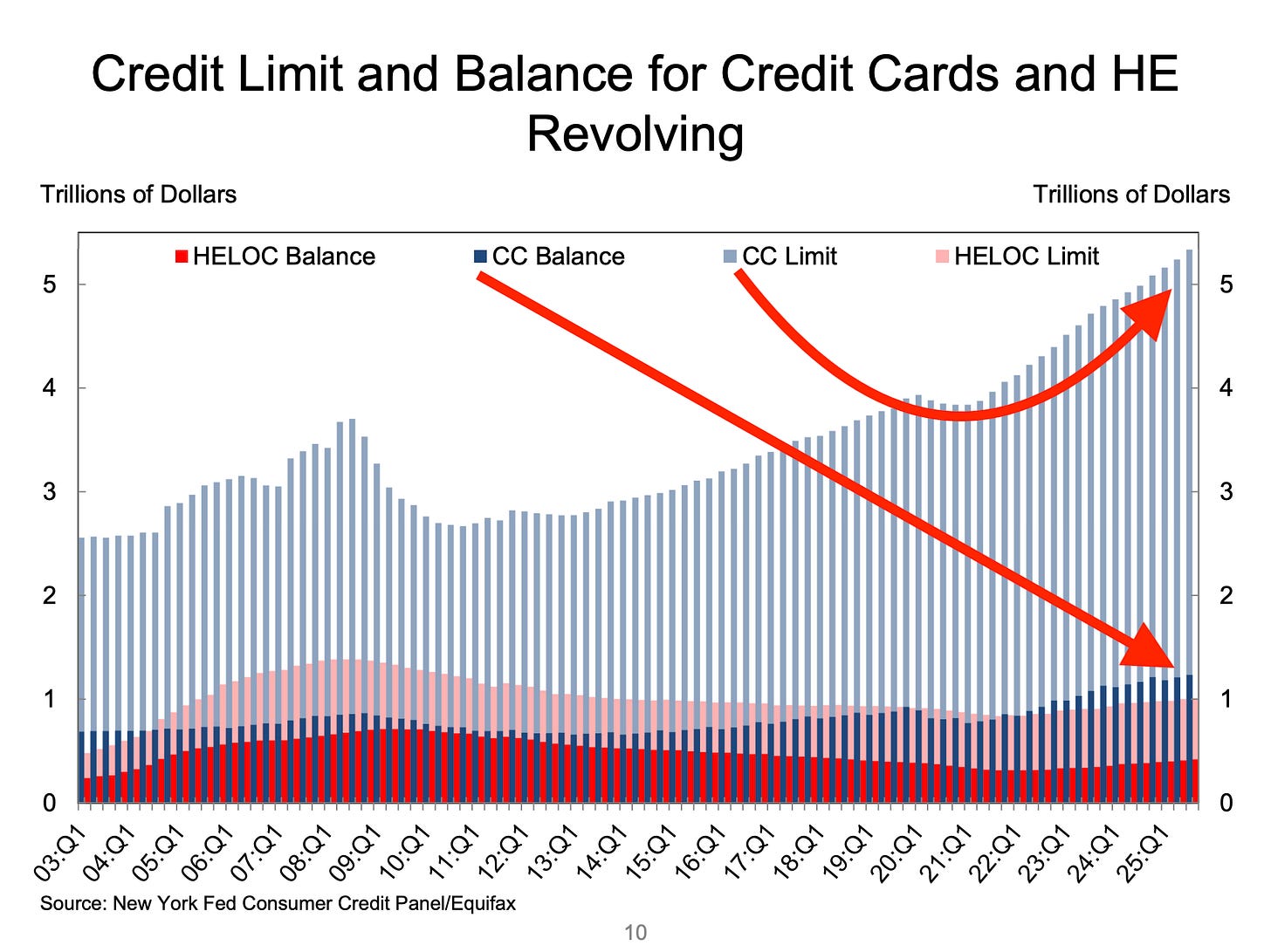
“Household debt balances are growing at a moderate pace, with delinquency rates stabilizing,” said NY Fed economist Donghoon Lee. “The relatively low mortgage delinquency rates reflect the housing market’s resilience, driven by ample home equity and tight underwriting standards.”
💵 Bank lending standards are mostly stable. According to the Federal Reserve’s October Senior Loan Officer Opinion Survey, lenders tightened standards for businesses as demand for loans increased. Lending standards for households were mostly stable.
From the Fed: “Regarding loans to businesses over the third quarter, survey respondents reported, on balance, tighter lending standards for commercial and industrial (C&I) loans to firms of all sizes.”
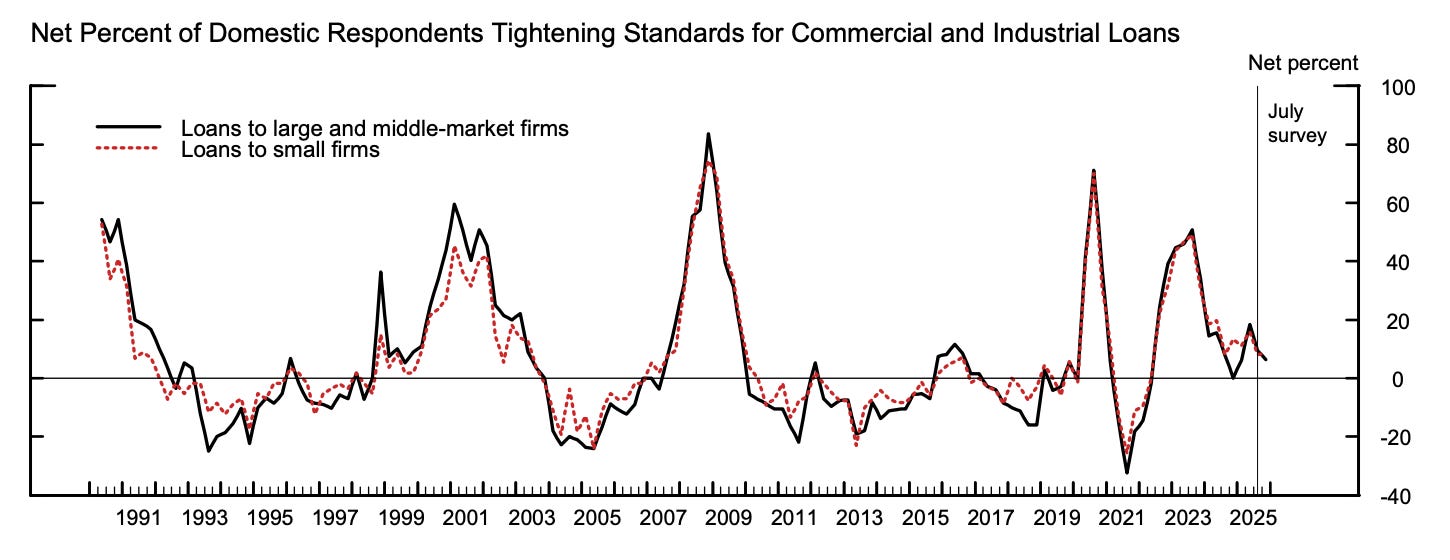
“Banks also reported, on balance, stronger demand for C&I loans from large and middle-market firms and basically unchanged demand from small firms.”
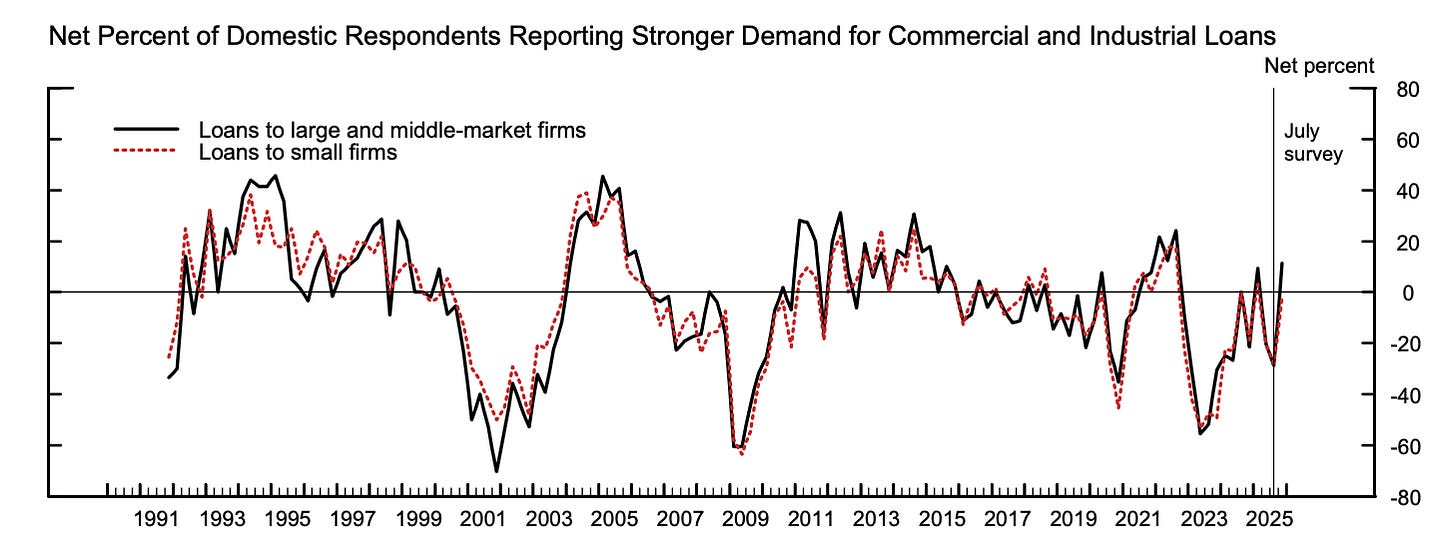
“For loans to households, banks reported basically unchanged lending standards and stronger demand for residential mortgage loans and home equity lines of credit (HELOCs) on balance.”

“For consumer loans, standards remained basically unchanged for credit card and other consumer loans and eased for auto loans.”

“Meanwhile, demand remained basically unchanged for credit card and other consumer loans and weakened for auto loans.“

Tighter lending standards act as a headwind to economic activity, but can also ease inflation pressures.
For more on economic activity, read: 9 once-hot economic charts that cooled 📉 and We’re at an economic tipping point ⚖️
👍 Inflation expectations ease. From the New York Fed’s October Survey of Consumer Expectations: “Median inflation expectations decreased by 0.2 percentage point to 3.2% at the one-year-ahead horizon in October. They were unchanged at the three-year- (3.0%) and five-year-ahead (3.0%) horizons.”

⛽️ Gas prices tick higher. From AAA: “Gas prices remain relatively stable as November kicks off. The national average for a gallon of regular went up nearly 5 cents since last week to $3.08. Refinery maintenance in California is part of the reason for the increase: when refineries pause production, gas prices in the area temporarily go up. Still, the national average is lower than it was this time last year, and gas prices should remain on a quiet path as we get closer to Thanksgiving.”
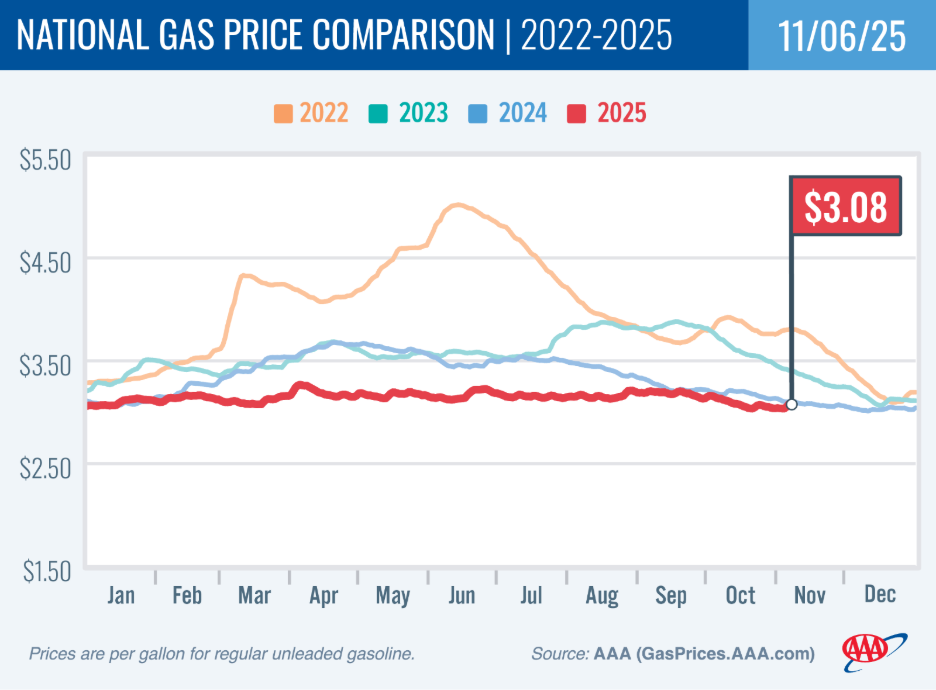
For more on energy prices, read: Higher oil prices meant something different in the past 🛢️
🏠 Mortgage rates tick higher. According to Freddie Mac, the average 30-year fixed-rate mortgage rose to 6.22%, up from 6.17% last week: “Mortgage rates decreased for the fourth consecutive week. The last few months have brought lower rates and homebuyers are increasingly entering the market.”

As of the summer, there were 147.9 million housing units in the U.S., of which 86.1 million were owner-occupied and about 39% were mortgage-free. Of those carrying mortgage debt, almost all have fixed-rate mortgages, and most of those mortgages have rates that were locked in before rates surged from 2021 lows. All of this is to say: Most homeowners are not particularly sensitive to the small weekly movements in home prices or mortgage rates.
For more on mortgages and home prices, read: Why home prices and rents are creating all sorts of confusion about inflation 😖
👎 Consumer vibes are in the dumps. From the University of Michigan’s November Surveys of Consumers: “Consumer sentiment fell back about 6% this November, led by a 17% drop in current personal finances and a 11% decline in year-ahead expected business conditions. With the federal government shutdown dragging on for over a month, consumers are now expressing worries about potential negative consequences for the economy. This month’s decline in sentiment was widespread throughout the population, seen across age, income, and political affiliation. One key exception: consumers with the largest tercile of stock holdings posted a notable 11% increase in sentiment, supported by continued strength in stock markets.”
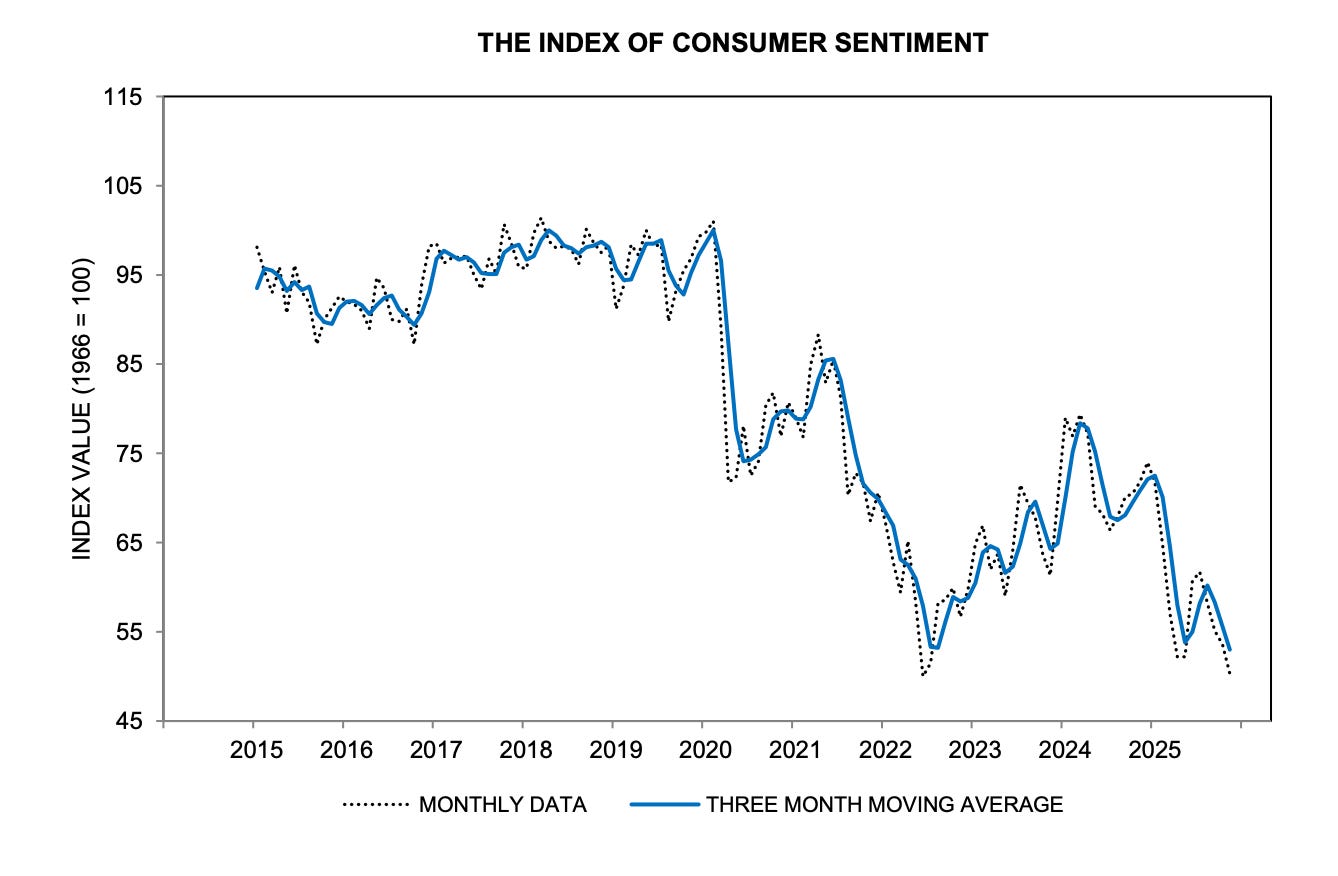
Relatively weak consumer sentiment readings appear to contradict relatively strong consumer spending data. For more on this contradiction, read: What consumers do > what consumers say 🙊 and We’re taking that vacation whether we like it or not 🛫
Politics clearly plays a role in people’s perception of the economy. But as Bloomberg’s Michael McDonough observed: “No one seems to like a shutdown. Preliminary October UMich Consumer Sentiment data out this morning shows sentiment dropped across party lines.”
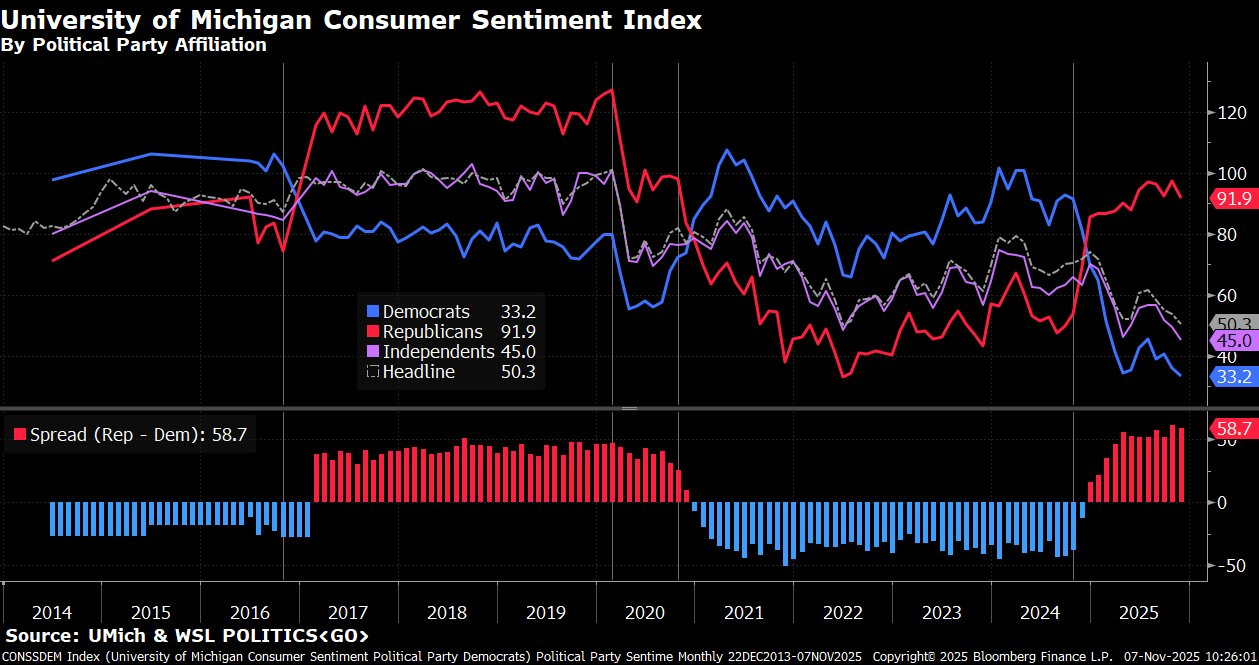
For more on how politics affects sentiment, read: Beware how your politics distort how you perceive economic realities 😵💫
🤷🏻♂️ Manufacturing activity surveys were mixed. From S&P Global’s October U.S. Manufacturing PMI: “US manufacturers reported a solid start to the fourth quarter with production rising at an increased rate in response to an encouragingly robust jump in new orders. However, lift the hood and the picture is not so healthy. Most worrying is the unprecedented rise in unsold stock reported in October, widely linked to weaker than anticipated sales to customers, especially in export markets, which could trigger a downshifting of production in the coming months unless demand revives.”
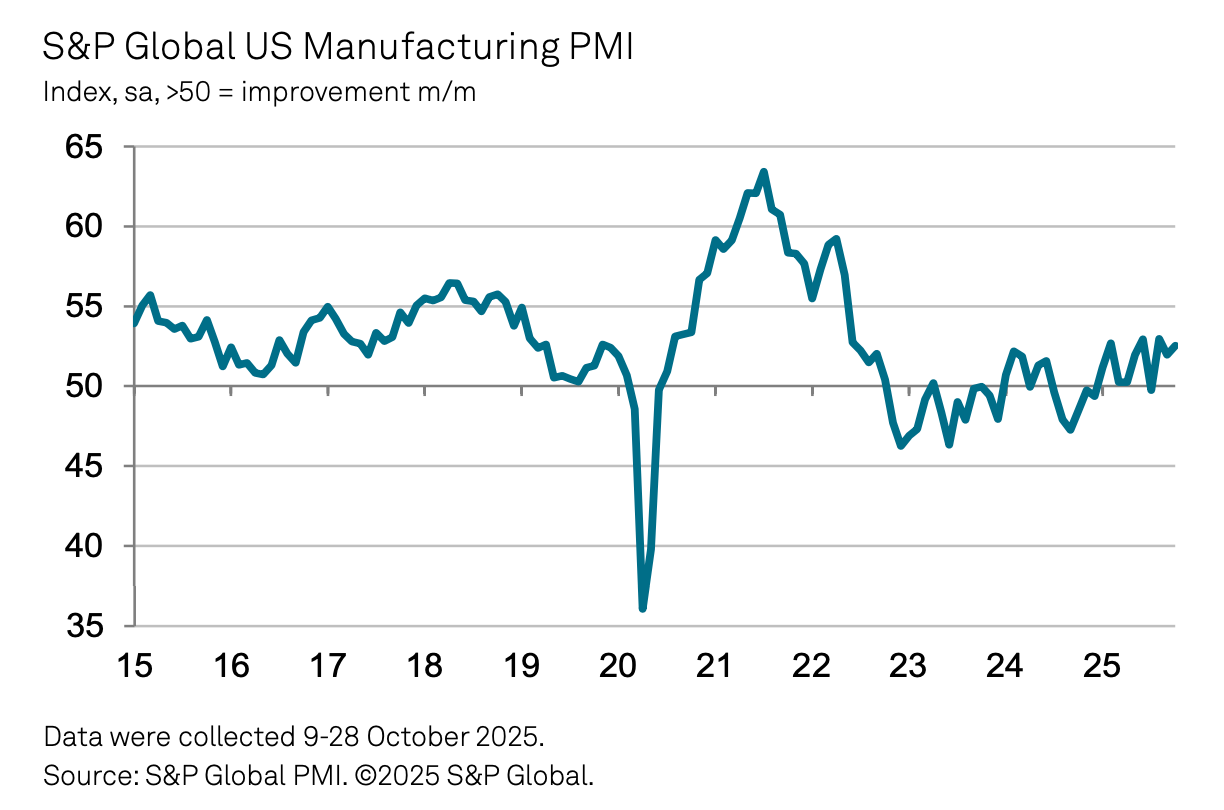
The ISM’s October Manufacturing PMI suggests the sector is contracting and that the pace of contraction has deteriorated from the prior month.

👍 Services activity surveys improve. From S&P Global’s October U.S. Services PMI: “Growth in the vast services economy has picked up speed to accompany an improved performance in the manufacturing sector. In total, business activity is growing at a rate commensurate with GDP rising at an annualized pace of around 2.5% after a similarly solid expansion was signalled for the third quarter. … However, there are signs that new business is coming at the cost of service providers having to soak up continued high input price growth to remain competitive. Customers are often pushing back on price rises, especially in consumer-facing markets. While good news in terms of inflation, this lack of pricing power hints at weak underlying demand and lower profits.”
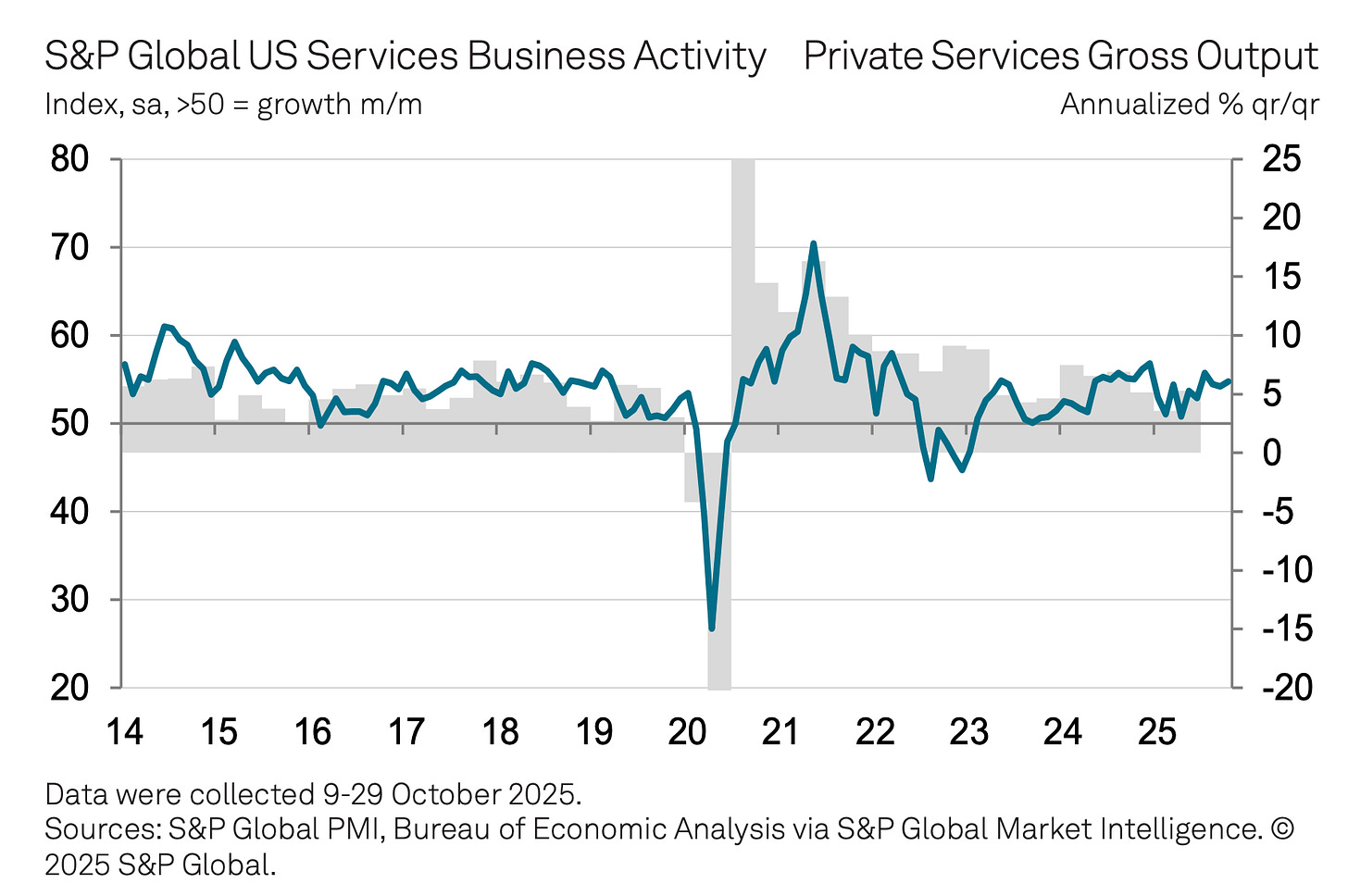
Similarly, the ISM’s October Services PMI signaled accelerating growth in the sector.

Keep in mind that during times of perceived stress, soft survey data tends to be more exaggerated than actual hard data.
For more on this, read: What businesses do > what businesses say 🙊
📈 Near-term GDP growth estimates are tracking positively. The Atlanta Fed’s GDPNow model sees real GDP growth rising at a 4.0% rate in Q3.
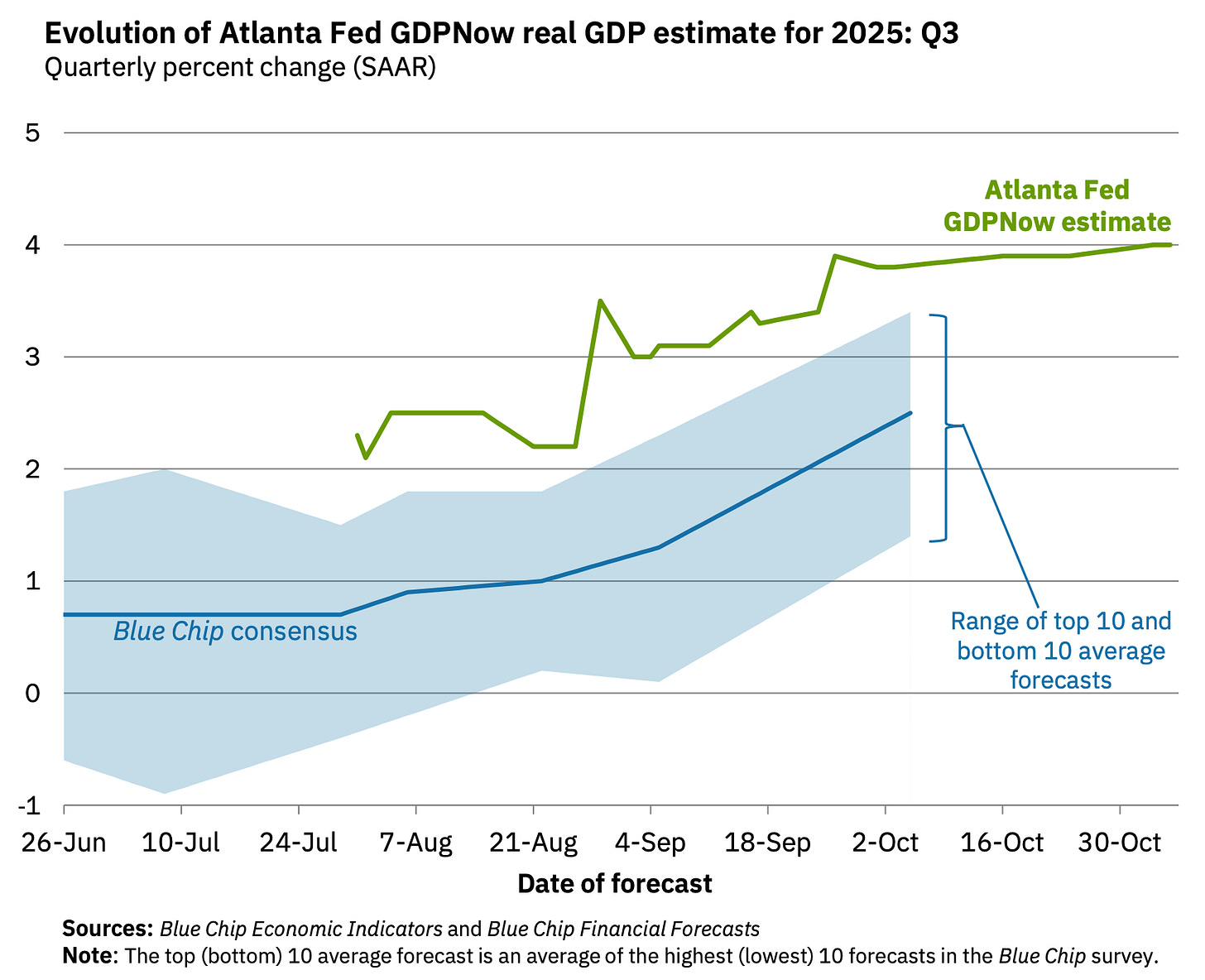
For more on GDP and the economy, read: 9 once-hot economic charts that cooled 📉 and We’re at an economic tipping point ⚖️
Putting it all together 📋
🚨 The Trump administration’s pursuit of tariffs is disrupting global trade, with significant implications for the U.S. economy, corporate earnings, and the stock market. Furthermore, the absence of economic data from federal agencies due to the government shutdown has made it more challenging to read the economy. Until we get more clarity, here’s where things stand:
Earnings look bullish: The long-term outlook for the stock market remains favorable, bolstered by expectations for years of earnings growth. And earnings are the most important driver of stock prices.
Demand is positive: Demand for goods and services remains positive, supported by healthy consumer and business balance sheets. Job creation, although cooling, appears to be modestly positive, and the Federal Reserve — having resolved the inflation crisis — shifted its focus toward supporting the labor market.
But growth is cooling: While the economy remains healthy, growth has normalized from much hotter levels earlier in the cycle. The economy is less “coiled” these days as major tailwinds like excess job openings and core capex orders have faded. It has become harder to argue that growth is destiny.
Actions speak louder than words: We are in an odd period, given that the hard economic data decoupled from the soft sentiment-oriented data. Consumer and business sentiment has been relatively poor, even as tangible consumer and business activity continues to grow and trend at record levels. From an investor’s perspective, what matters is that the hard economic data continues to hold up.
Stocks are not the economy: There’s a case to be made that the U.S. stock market could outperform the U.S. economy in the near term, thanks largely to positive operating leverage. Since the pandemic, companies have aggressively adjusted their cost structures. This came with strategic layoffs and investment in new equipment, including hardware powered by AI. These moves are resulting in positive operating leverage, which means a modest amount of sales growth — in the cooling economy — is translating to robust earnings growth.
Mind the ever-present risks: Of course, we should not get complacent. There will always be risks to worry about, such as U.S. political uncertainty, geopolitical turmoil, energy price volatility, and cyber attacks. There are also the dreaded unknowns. Any of these risks can flare up and spark short-term volatility in the markets.
Investing is never a smooth ride: There’s also the harsh reality that economic recessions and bear markets are developments that all long-term investors should expect as they build wealth in the markets. Always keep your stock market seat belts fastened.
Think long-term: For now, there’s no reason to believe there’ll be a challenge that the economy and the markets won’t be able to overcome over time. The long game remains undefeated, and it’s a streak that long-term investors can expect to continue.
For more on how the macro story is evolving, check out the previous review of the macro crosscurrents. »
Key insights about the stock market 📈
Here’s a roundup of some of TKer’s most talked-about paid and free newsletters about the stock market. All of the headlines are hyperlinked to the archived pieces.
10 truths about the stock market 📈
The stock market can be an intimidating place: It’s real money on the line, there’s an overwhelming amount of information, and people have lost fortunes in it very quickly. But it’s also a place where thoughtful investors have long accumulated a lot of wealth. The primary difference between those two outlooks is related to misconceptions about the stock market that can lead people to make poor investment decisions.
The makeup of the S&P 500 is constantly changing 🔀
Passive investing is a concept usually associated with buying and holding a fund that tracks an index. And no passive investment strategy has attracted as much attention as buying an S&P 500 index fund. However, the S&P 500 — an index of 500 of the largest U.S. companies — is anything but a static set of 500 stocks.

The key driver of stock prices: Earnings💰
For investors, anything you can ever learn about a company matters only if it also tells you something about earnings. That’s because long-term moves in a stock can ultimately be explained by the underlying company’s earnings, expectations for earnings, and uncertainty about those expectations for earnings. Over time, the relationship between stock prices and earnings has a very tight statistical relationship.

Stomach-churning stock market sell-offs are normal🎢
Investors should always be mentally prepared for some big sell-offs in the stock market. It’s part of the deal when you invest in an asset class that is sensitive to the constant flow of good and bad news. Since 1950, the S&P 500 has seen an average annual max drawdown (i.e., the biggest intra-year sell-off) of 14%.
How the stock market performed around recessions 📉📈
Every recession in history was different. And the range of stock performance around them varied greatly. There are two things worth noting. First, recessions have always been accompanied by a significant drawdown in stock prices. Second, the stock market bottomed and inflected upward long before recessions ended.

In the stock market, time pays ⏳
Since 1928, the S&P 500 has generated a positive total return more than 89% of the time over all five-year periods. Those are pretty good odds. When you extend the timeframe to 20 years, you’ll see that there’s never been a period where the S&P 500 didn’t generate a positive return.

What a strong dollar means for stocks 👑
While a strong dollar may be great news for Americans vacationing abroad and U.S. businesses importing goods from overseas, it’s a headwind for multinational U.S.-based corporations doing business in non-U.S. markets.

Stanley Druckenmiller's No. 1 piece of advice for novice investors 🧐
…you don't want to buy them when earnings are great, because what are they doing when their earnings are great? They go out and expand capacity. Three or four years later, there's overcapacity and they're losing money. What about when they're losing money? Well, then they’ve stopped building capacity. So three or four years later, capacity will have shrunk and their profit margins will be way up. So, you always have to sort of imagine the world the way it's going to be in 18 to 24 months as opposed to now. If you buy it now, you're buying into every single fad every single moment. Whereas if you envision the future, you're trying to imagine how that might be reflected differently in security prices.
Peter Lynch made a remarkably prescient market observation in 1994 🎯
Some event will come out of left field, and the market will go down, or the market will go up. Volatility will occur. Markets will continue to have these ups and downs. … Basic corporate profits have grown about 8% a year historically. So, corporate profits double about every nine years. The stock market ought to double about every nine years… The next 500 points, the next 600 points — I don’t know which way they’ll go… They’ll double again in eight or nine years after that. Because profits go up 8% a year, and stocks will follow. That's all there is to it.
Warren Buffett's 'fourth law of motion' 📉
Long ago, Sir Isaac Newton gave us three laws of motion, which were the work of genius. But Sir Isaac’s talents didn’t extend to investing: He lost a bundle in the South Sea Bubble, explaining later, “I can calculate the movement of the stars, but not the madness of men.” If he had not been traumatized by this loss, Sir Isaac might well have gone on to discover the Fourth Law of Motion: For investors as a whole, returns decrease as motion increases.
Most pros can’t beat the market 🥊
According to S&P Dow Jones Indices (SPDJI), 65% of U.S. large-cap equity fund managers underperformed the S&P 500 in 2024. As you stretch the time horizon, the numbers get even more dismal. Over a three-year period, 85% underperformed. Over a 10-year period, 90% underperformed. And over a 20-year period, 92% underperformed. This 2023 performance follows 14 consecutive years in which the majority of fund managers in this category have lagged the index.
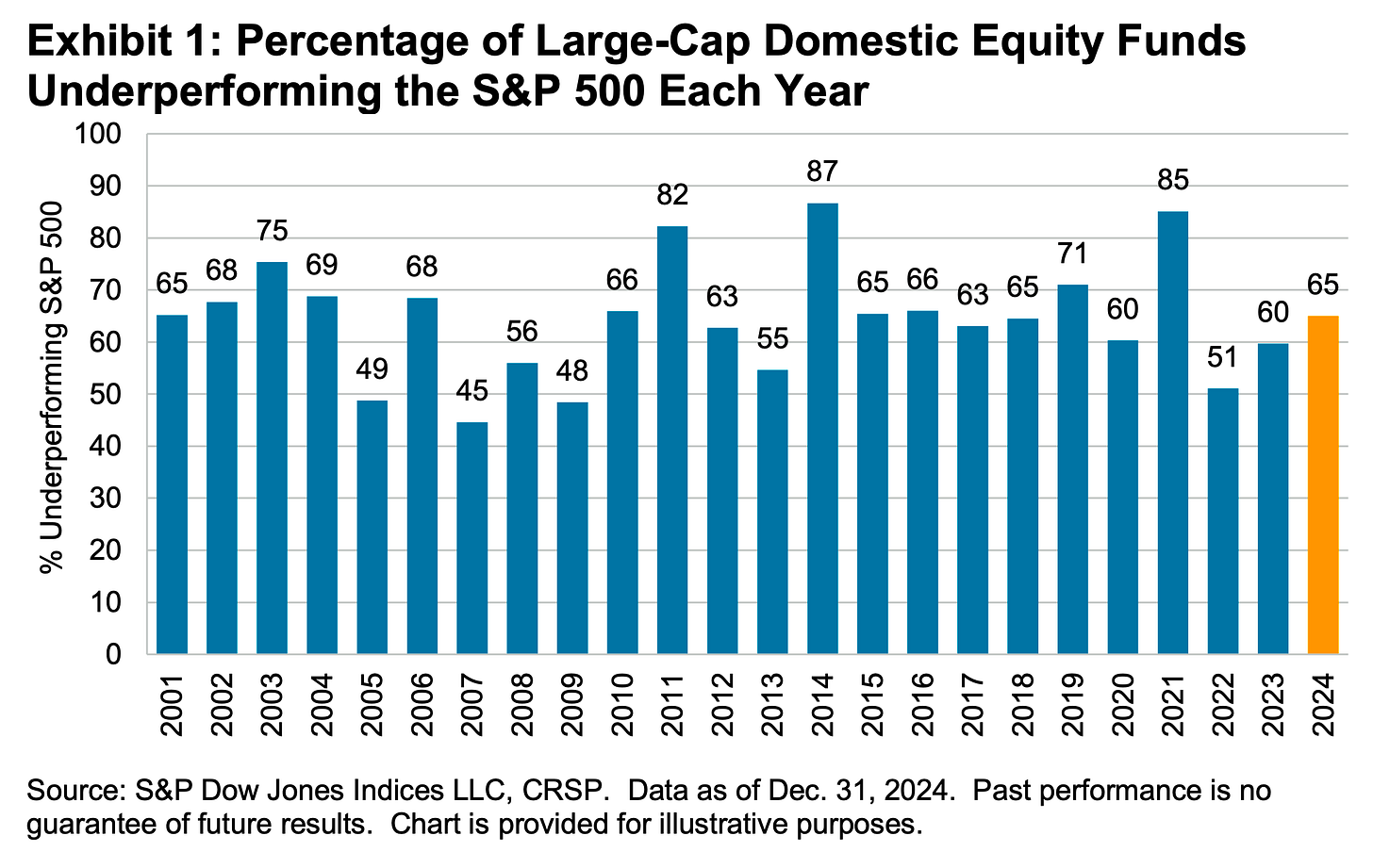
Proof that 'past performance is no guarantee of future results' 📊
Even if you are a fund manager who generated industry-leading returns in one year, history says it’s an almost insurmountable task to stay on top consistently in subsequent years. According to S&P Dow Jones Indices, just 4.21% of all U.S. equity funds in the top half of performance during the first year were able to remain in the top during the four subsequent years. Only 2.42% of U.S. large-cap funds remained in the top half
SPDJI’s report also considered fund performance relative to their benchmarks over the past three years. Of 738 U.S. large-cap equity funds tracked by SPDJI, 50.68% beat the S&P 500 in 2022. Just 5.08% beat the S&P in the two years ending 2023. And only 2.14% of the funds beat the index over the three years ending in 2024.

The odds are stacked against stock pickers 🎲
Picking stocks in an attempt to beat market averages is an incredibly challenging and sometimes money-losing effort. Most professional stock pickers aren’t able to do this consistently. One of the reasons for this is that most stocks don’t deliver above-average returns. According to S&P Dow Jones Indices, only 19% of the stocks in the S&P 500 outperformed the average stock’s return from 2001 to 2025. Over this period, the average return on an S&P 500 stock was 452%, while the median stock rose by just 59%.
